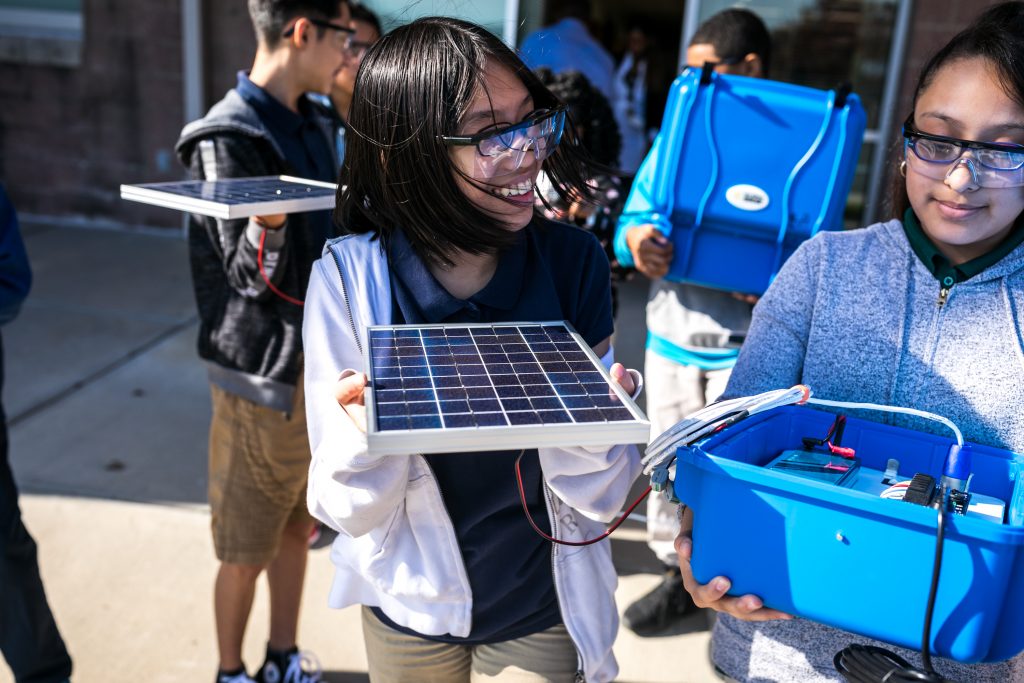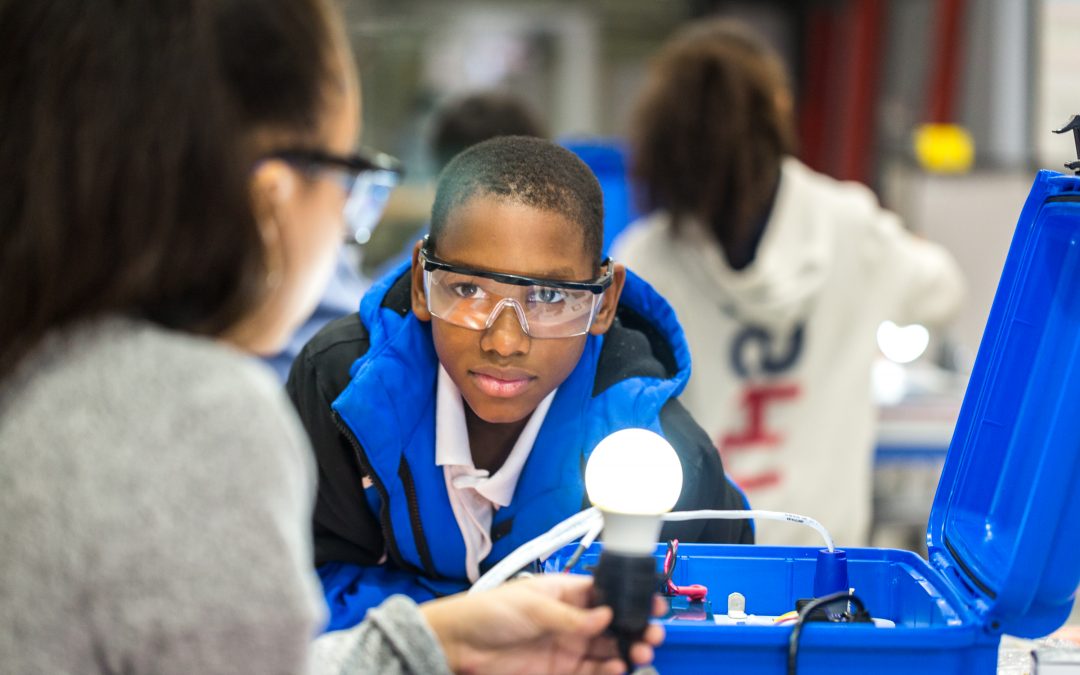By. Nicole Sherrod-Hill, Whitewater Middle School
Whitewater Middle School is breaking ground in more ways than one. The school, part of the Charlotte-Mecklenburg School system, is in the middle of a transition to becoming an E-STEM (Environmental Science, Technology, Engineering, Math) school, with support from Green Schools National Network and Project Lead the Way (PLTW). That’s impressive enough, however, Whitewater is also the recipient of a Verizon Innovation Learning Lab. It’s one of the largest such Innovation Learning Labs in the country and the only one in the state of North Carolina. The lab was gifted to Whitewater through a grant the school applied for during the 2016 – 2017 school year. Construction on the lab started in summer 2018 and the lab officially opened in October 2018. Since then, it’s been a whirlwind of innovative learning and growing for Whitewater students and teachers alike.
Design Thinking Comes to Life
Whitewater kicked-off its use of the Innovation Learning Lab with its PLTW classes. Students spent the first two weeks of school learning about engineering and the steps involved in the design process. By the third week, students were ready to branch out into projects related to the courses they were taking.
During the first semester, sixth-graders taking the Energy and Environment course focused on the importance of knowing and understanding various forms of energy. Students participated in a heat transfer lab where they determined which materials make good insulators. They built Solar Suitcases (i.e. portable power units) from scratch and sent them to Africa for use as electricity sources. They also explored ideas and designs for windmills and built kites made from recycled materials.
Seventh-graders taking the Science of Technology course explored architectural drawing and drafting by completing a Revit software tutorial, where they learned how to properly read and write architectural measurements and understand scale and arrangements on blueprints. They also learned about simple and complex machines, designing and building a marble roller coaster and a wooden dragster.
Eighth-graders in the Green Architecture course used Revit software to create 3D floor plans and models for a classroom and a dream bedroom. Students also learned about the construction process and built a frame for a shed and several full-size dog houses at the request of a few school staff members.
Course-related project work for all three grades was interspersed with Discovery Place lessons that introduced students to the Innovation Learning Lab space. During these lessons, students created a water drainage system and school signs using recycled materials, wire hanging plants to hang in the lab, and a soundproof quilt made from plarn (plastic yarn) and other recycled materials. In addition, each week of the semester concluded with a design challenge where students worked together to solve problems. Challenges included using toothpicks and marshmallows to build a tower and constructing a wind sail car or a propeller vehicle.
During the second semester, PLTW students used the Innovation Learning Lab to tackle three new courses. In the Design and Modeling course, sixth-graders designed and created a model of an original vehicle powered by the energy of one standard size mousetrap. They also designed and created a foot orthotic prototype that had to be worn by a group member to test its effectiveness. In the Automation and Robotics course, seventh-graders designed and created an original pull toy and a clawbot, the latter of which had to be designed to move by remote control. Both products were tested to analyze their effectiveness. In the Space and Flight course, eighth-graders designed and created a virtual model glider using WhiteBox learning engineering software, as well as a balsa wood glider. For the balsa wood glider, students tested their glider designs virtually before building the actual glider. Both virtual models and wood gliders were tested for best glide times.
In addition to the new course work, all three grades participated in Engineering Week where they explored careers related to their current courses. Students discussed high school pathways (programs) that aligned with their interests and identified high schools that offered those programs. They also participated in webinars via Nepris, an online platform provided by Verizon Innovation Learning.

Teachers Get Schooled in Innovation
Of course, students can’t take full advantage of what the Innovation Learning Lab has to offer without knowledgeable teachers guiding the way. In February 2019, the Innovation Learning Lab Coordinator (the author) and PLTW teacher Keith Coles joined forces to start a series of staff trainings to help content teachers integrate technology, problem-solving, and design thinking into their classes, while also covering required standards. Some examples of trainings include:
- English language Arts and Spanish teachers learned how to conduct electronic author interviews using blabberize and imovie.
- Science teachers worked on creating 3D model designs to solve environmental problems using biomimicry principles.
- Social Studies teachers elected to learn how to create Video Biographies, Artifact Interviews, and/or Revolution Video Projects.
- Electives teachers learned to use programs such as Tinkercad, Sketchfab, and Metaverse to create 3D models for content topics such as composers (Music), the human body (Health and P.E.), and famous artists (Art).
All teachers were given an opportunity during these sessions to create their own exemplars and lesson plans, and then were scheduled for time in the Innovation Learning Lab to teach students to do the same.
Student and Community Impact
One of Whitewater’s initial goals for the Innovation Learning Lab was to introduce students to the design thinking process and help them to use design thinking across all subjects. The lab’s hands-on approach supports this goal, allowing students to observe, gain insight, and develop different ways to solve a problem. It’s “design problem-solving on steroids,” PLTW teacher Ken Dawson says.
Whitewater students are responding positively to their experiences in the Innovation Learning Lab. According to a recent student survey:
- 48% report that their experiences in their classes and the lab have translated into higher academic performance.
- 62.5% report being more interested in STEM subjects.
- 49% say they have developed better problem solving skills, 53% say they have better communication skills, 54% say they have better collaboration skills, and 50% report feeling more confident.
Since the lab opened in October 2018, Whitewater has played host to local superintendents and principals, as well as guests from schools across the country, who want to see the lab space and some of the products being produced and learn how the lab functions on a daily basis. As a result of this attention, Whitewater’s student tech team received training on all things “Innovation Learning Lab” so they are prepared to speak about everything, from lab equipment to ongoing projects. Students have also been trained to do interviews with media outlets. They are truly rising to the occasion as leaders and supporters of the Innovation Learning Lab in many different ways.

Lessons Learned
As one of the first schools to host a Verizon Innovation Learning Lab, Whitewater has learned many valuable lessons that have since translated into best practices. When the lab first opened, there was a lot of pressure to get students and content teachers into the lab right away. As the Innovation Learning Lab Coordinator, the author learned not to over-promise and underdeliver, but to take it slow and pace things so there was time to evaluate and tweak as needed. The author created a scheduling system that built in teacher support upfront before classes entered the lab. This gave teachers time to get to know the space and the equipment, as well as ensure that materials were prepped and ready for students to use once they were in the lab. The goal was to make sure that teachers had a positive and successful first experience so they would be inspired to try out more innovative lesson ideas in the lab. Because of the tremendous support provided to teachers, students know that when they come to the lab they must take care of it and treat it with respect. They also know that it’s a place where collaboration, conversation, innovation, and creation happen, which fills the space with fun, laughter, and positive energy.
Author Bio
Nicole Sherrod-Hill is the Innovation Learning Lab Coordinator and the CTE and Project Lead The Way Facilitator at Whitewater Middle School. She has over 24 years of experience in education, serving in leadership and teaching roles at Charlotte-Mecklenburg Schools in North Carolina, Prince George’s County Public Schools and Talbot County Public Schools in Maryland, and Alexandria City Public Schools in Virginia. She holds a bachelor’s degree in elementary education from Carlow University in Pittsburgh, Pennsylvania, a master’s degree in Curriculum and Instruction and Administration from McDaniel College in Maryland, and a master’s degree as a reading specialist from Regent University in Virginia.

